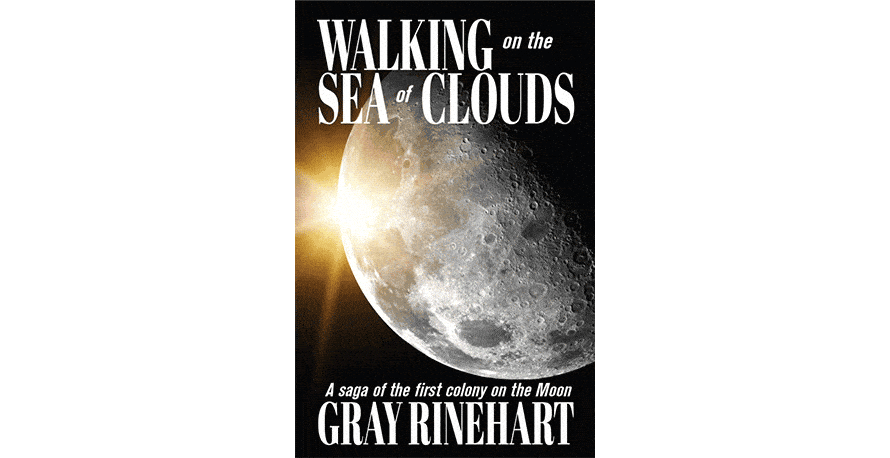Category: Fiction
Reviewed by: Mark Lardas
Title: Walking on the Sea of Clouds
Author: Gray Rinehart
NSS Amazon link for this book
Format: Paperback/Kindle
Pages: 386
Publisher: WordFire Press
Date: July 2017
Retail Price: $19.99/$5.99
ISBN: 978-1614755210
Image life on the first Lunar colony. It probably provokes visions of high adventure in a high tech environment. Reality would likely differ. It would be cramped, dangerous, smelly, uncomfortable, frequently tedious, exhilarating yet terrifying—and an adventure of a lifetime.
Walking on the Sea of Clouds, a science fiction novel by Gray Rinehart opts for reality. He tells the story of setting up the first commercial colony on the Moon.
The story follows the fortunes of two couples who are lunar pioneers: Stormie and Frank Pastorelli and Van and Barbara Richards. Only Van Richards is on the Moon when the novel starts. The rest are candidates for the colony. The Pastorellis are independent contractors while the Richards couple are employees of the consortium building a Moon base on the Sea of Clouds.
Rinehart takes the reader, along with these four characters, through the process of qualifying to go to the Moon, and follows their activities once they get there. All four have different motivations and interests. Rinehart populates his book with well-developed and three dimensional characters. They are smart and share a vision of building a new world on a new planetary body. Some are motivated by money, but there are easier ways to make money. For most, money is a way to keep score, a way to justify the hardships and challenges of being pioneers.
Rinehart’s Moon is a dangerous place, made more dangerous by the economic realities of a commercial enterprise in a hazardous location. Think the building of Hoover Dam or the challenges of installing the first North Sea oil platform. Equipment fails. The law of unintended consequences kicks in. Humans make human errors with cascading consequences.
The result is a story which draws readers in despite a lack of good guys and bad guys. Instead there are people who come into conflict due to conflicting perspectives and goals. There are heroes, but no real villains, except perhaps the implacable Moon.
This is hard science fiction. Rinehart describes the nuts and bolts of the various systems required in a Moon colony with an accuracy drawn from participating in Air Force space operations. At times it reads like a NASA mission description. Yet he keeps the focus on the individuals and their goals, producing an exciting and at times intimate story of human accomplishment in the face of adversity.
While a modern story, it also captures the optimism and yearnings seen during the early years of the Space Age, when the sky was literally the limit. It captures the flavor of the SF of that era, especially the stories from Astounding and Analog Science Fiction when John Campbell was editing it.
This is Rinehart’s first novel. Although as entertaining as some of Heinlein’s early fiction, it is not Heinlein, despite many Heinlein tropes. It seems closer to the type of fiction Jerry Pournelle wrote in the 1960s and 1970s. The style is clearly Rinehart’s own, both readable and involving.
There are a few rough edges, as would be expected in a first novel. None distract from the story. Rinehart also avoids the trap of writing a feel-good ending, where everything ends happily-ever-after. Rather he chooses to show the price of pushing back frontiers.
Walking on the Sea of Clouds is the type of story seen too rarely today. It captures a pioneering era that once was and could be again. Those who seek to explore space will read this and say, this is what pioneering space would and should be like.
© 2017 Mark Lardas
Please use the NSS Amazon Link for all your book and other purchases. It helps NSS and does not cost you a cent! Bookmark this link for ALL your Amazon shopping!



















